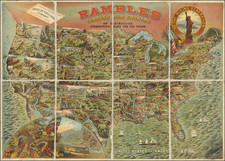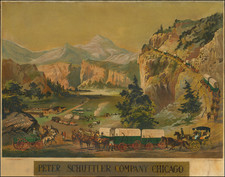Important early geological survey map of the Black Hills region, undertaken by William Ludlow, while under the command of George Custer.
In 1874, a large group of cavalrymen under the command of Lt. Col. George Armstrong Custer moved into the Black Hills region of Dakota Territory. Though officially American Indian Territory according to the 1868 Treaty of Laramie, rumors had been circulating since the early 19th century that this region harbored rich deposits of gold. Custer and his men were sent to investigate. The expedition included William Ludlow, an officer of the Army Corps of engineers, whose commission was to explore and survey the region, identifying in the process if the rumored gold did indeed exist.
Ludlow and Custer traveled west from Fort Lincoln on the Missouri River (near Bismarck), to the Powder River, then on to the Black Hills. The map meticulously documents the survey triangulation points and encampments. Ludlow offers commentary on the territory such as 'High hills heavily timbered water and grass abundant,' 'grass and water good,' 'bad lands' and 'soil and loose dry clay.' Ultimately, Custer and his men did find gold in the Black Hills, leading to the 1876 Black Hills Gold Rush.
The geological information on this map was prepared by Newton Horace Winchell, who accompanied the 1874 expedition. He is most known for his work on the geology of Minnesota.
William Ludlow (1843 - 1901) was an officer in the Corps of Engineers and a major general in the United States Army who served in the Civil War, Plains Indian Wars, the Spanish-American War, and led a scientific expedition examining the natural wonders of Yellowstone National Park. After the Civil War, Ludlow served in Charleston, South Carolina under Major Q.A. Gilmore until November 14, 1872, when he was reassigned to serve as Chief Engineer of Dakota Territory, where he oversaw mapping and data collection of the 7th Cavalry's 1874 expedition into the Black Hills of what is now South Dakota









![[ Southern Railroads ] Railroad Map of the Southern States Shewing the Southern & Southwestern Railway Connections With Philadelphia. 1862 . . . Prepared by Thomas Kimber Jr., Chairman of the Committee on Inland Transportation of the Board of Trade of Philadelphia](https://storage.googleapis.com/raremaps/img/small/103211.jpg)


![History of the Expedition under the Command of Captains Lewis and Clark, to the Sources of the Missouri Thence across the Rocky Mountains and Down the River Columbia to the Pacific Ocean, Performed During the Years 1804-5-6 [with map:] Map of Lewis and Clark's Track, Across the Western Portion of North America from the Mississippi to the Pacific Ocean](https://storage.googleapis.com/raremaps/img/small/92506.jpg)

![Mapa et tierra q[u]e yos pedro Vial taigo transitau en St. Tafee este dia 18 de Octubre de La ao 1787](https://storage.googleapis.com/raremaps/img/small/3645.jpg)